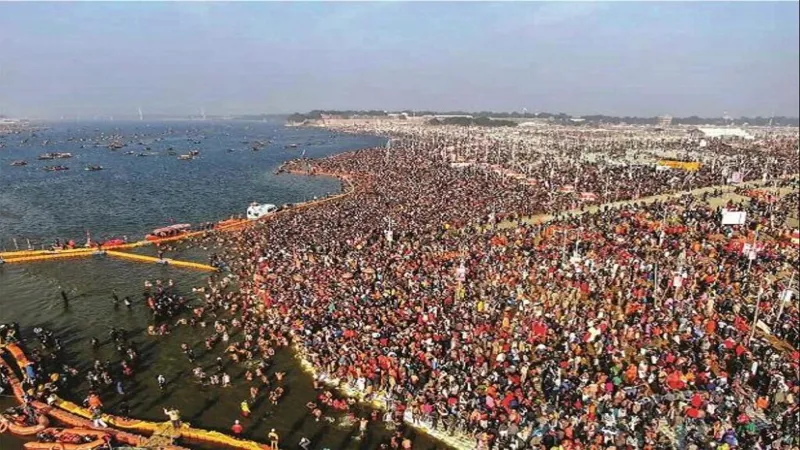The Maha Kumbh Mela, a monumental religious festival that draws millions of devotees from across India, is currently underway in Prayagraj, Uttar Pradesh. Indian Railways has risen to the occasion, facilitating the seamless travel of pilgrims by operating an impressive fleet of over 14,000 trains. As one of the largest religious gatherings globally, the Kumbh Mela has seen a staggering 36 million attendees relying on railway services. With additional trains and meticulous traffic management, Indian Railways has not only ensured efficient transportation but also played a pivotal role in making this spiritual journey accessible to countless devotees.
| Category | Details |
|---|---|
| Event | Maha Kumbh Mela in Prayagraj, Uttar Pradesh |
| Role of Indian Railways | Transported millions of pilgrims, operating over 14,000 trains. |
| Number of Devotees | 36 million devotees used railway services. |
| Train Services | 92% were mail, express, superfast, passenger, MEMU services; included 472 Rajdhani and 282 Vande Bharat trains. |
| Origin of Trains | 50% from Uttar Pradesh, 11% from Delhi, 10% from Bihar, 3-6% from Maharashtra, West Bengal, Madhya Pradesh, Rajasthan, Gujarat. |
| Total Devotees Travelling by Train | Estimated 120 to 150 million devotees over 1.5 months. |
| Train Arrivals at Prayagraj | 13,667 trains arrived at Prayagraj and nearby stations. |
| Special Trains | 3,468 special trains from Kumbh area, 2,008 from other locations, 8,211 regular services. |
| Train Handling at Major Stations | Prayagraj Junction (5,332 trains), Subedarganj (4,313), Naini (2,017), Cheoki (1,993), Prayag Junction (1,326), Jhusi (1,207), Phaphamau (1,010), Prayagraj-Rambagh (764), Prayagraj-Sangam (515). |
| State-wise Train Count | Uttar Pradesh (6,436), Delhi (1,343), Bihar (1,197), Maharashtra (740), West Bengal (560), Madhya Pradesh (400), Gujarat (310), Rajasthan (250), Assam (180). |
| Railway Minister’s Action | Ashwini Vaishnaw directed measures for passenger convenience at the Railway Board War Room. |
The Importance of Maha Kumbh Mela
The Maha Kumbh Mela is one of the largest religious gatherings in the world, bringing together millions of people from different parts of India. This festival is not just about rituals; it’s a time for devotion, community, and unity among pilgrims. Each time it occurs, it draws more worshippers, showcasing the significance of faith in Indian culture and how people come together to celebrate their beliefs.
During the Maha Kumbh, the atmosphere is filled with excitement and spirituality. Devotees travel from far and wide to immerse themselves in the sacred waters of the Ganges River. This event is a rich tapestry of traditions, rituals, and cultural exchanges, making it a unique experience for everyone involved. The sheer number of participants highlights the importance of this festival in the hearts of millions.
Indian Railways: A Lifeline for Devotees
Indian Railways plays a crucial role in facilitating the travel of pilgrims to the Maha Kumbh Mela. With over 14,000 trains operating during this time, the railway network ensures that devotees can reach their destination with ease and comfort. The efficient management of train schedules and services showcases how dedicated Indian Railways is to serving the needs of the public during such a significant event.
The scale of train operations is impressive, with 36 million devotees relying on rail services to attend the Kumbh. The variety of trains, from express to passenger services, caters to the diverse needs of travelers. This dedication not only helps in reducing congestion but also ensures that everyone has the opportunity to participate in this grand religious festival.
Managing the Train Traffic
To accommodate the massive influx of pilgrims, Indian Railways has implemented effective strategies to manage train traffic. Special trains are added to the regular schedule, and traffic flow is closely monitored to prevent overcrowding at stations. This careful planning helps ensure that pilgrims can travel safely and comfortably to their destinations.
With Prayagraj Junction handling thousands of trains, it’s essential to manage the flow of arrivals and departures. Stations like Subedarganj and Naini also play key roles in supporting this operation. By coordinating efforts across multiple stations, Indian Railways successfully handles the challenges of such a large-scale event, making the travel experience smoother for everyone.
Statistics of Train Services During Kumbh
The statistics surrounding train services during the Maha Kumbh Mela are impressive. A staggering 13,667 trains have already arrived at Prayagraj, demonstrating the incredible demand for rail travel. Special trains have been added to ensure that pilgrims from various states can reach the holy city without delay.
Uttar Pradesh alone accounted for the highest number of trains, highlighting its central role in the Kumbh experience. Other states, including Delhi and Bihar, also contributed significantly to train traffic, showcasing the widespread participation in this spiritual journey. These numbers reflect the dedication of Indian Railways in meeting the needs of millions of travelers.
Trains Originating from Various States
During the Maha Kumbh Mela, trains originating from different states help connect pilgrims to Prayagraj. Approximately half of the trains come from Uttar Pradesh, while significant contributions also come from states like Delhi and Bihar. This interconnectedness between states illustrates the collaborative spirit of the event.
The variety of trains from states such as Maharashtra and West Bengal demonstrates how the Maha Kumbh Mela is a national event, drawing people from all corners of India. This not only strengthens the bonds between different cultures but also enriches the overall experience for the devotees participating in this sacred occasion.
Railway Minister’s Oversight and Initiatives
Indian Railway Minister Ashwini Vaishnaw’s active involvement during the Kumbh highlights the importance of efficient travel management. By visiting the Railway Board War Room, he ensures that all necessary measures are taken to facilitate smooth travel for the pilgrims. His leadership plays a pivotal role in addressing any challenges that arise.
The Railway Board, under the guidance of CEO Satish Kumar, works diligently to enhance passenger convenience. This level of oversight ensures that the railway services remain reliable and efficient during the busy Kumbh season. The commitment of the Railway Minister and his team showcases the importance of government support in managing large-scale events like the Maha Kumbh.
Frequently Asked Questions
How many trains are operating for the Maha Kumbh Mela?
Indian Railways is operating over 14,000 trains to facilitate travel for pilgrims attending the Maha Kumbh Mela in Prayagraj.
How many devotees traveled by train during the Maha Kumbh?
Approximately 120 to 150 million devotees are estimated to have traveled by train to the Maha Kumbh over one and a half months.
What types of trains are used for the Kumbh Mela?
Around 92 percent of trains include mail, express, superfast, passenger, and MEMU services, along with special Rajdhani and Vande Bharat trains.
Which states contributed the most trains for the Kumbh Mela?
Uttar Pradesh led with 6,436 trains, followed by Delhi, Bihar, Maharashtra, and others contributing significantly.
What steps has Indian Railways taken to manage train traffic?
Indian Railways has run additional trains and effectively managed traffic to avoid congestion during the peak travel times of the Kumbh Mela.
How many special trains were operated from the Kumbh area?
A total of 3,468 special trains were operated from the Kumbh area to assist the large number of pilgrims.
What support did Prayagraj Junction provide during the Kumbh Mela?
Prayagraj Junction handled 5,332 trains, providing essential support and relief for the traveling pilgrims attending the Kumbh Mela.
Summary
Indian Railways has been vital in transporting millions of pilgrims to the Maha Kumbh Mela in Prayagraj, Uttar Pradesh, operating over 14,000 trains. This event, one of the largest religious gatherings in the world, saw around 36 million devotees using railway services. The majority of trains included mail, express, and superfast services, with significant traffic managed to prevent congestion. Special trains were added to accommodate the influx, and major stations like Prayagraj Junction handled thousands of arrivals. Overall, an estimated 120 to 150 million pilgrims traveled by train during this period.



